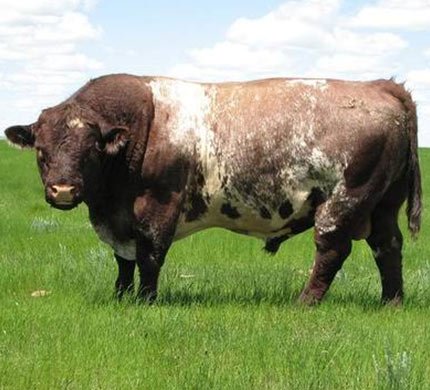Dairy Shorthorn
- Temperature:5°C to 20°C
- Milk:6,000 to 8,000 kg per year
- Food:Hay, Silage and Pasture
- Pregnancy:283 days
- Nationality:England

General Information
Dairy Shorthorn is a breed of cattle that originated in England in the late 18th century. They are a medium to large-sized breed, with cows weighing between 1,000 to 1,500 pounds and bulls weighing between 1,500 to 2,000 pounds. They are known for their high-quality milk production and their ability to produce milk over an extended period.
Dairy Shorthorns come in a variety of colors, including red, white, and roan. They have a short, smooth coat, and their skin is fine and mellow. They have a wide, deep body with a broad chest, straight back, and strong legs. Their udders are well-developed and high, with teats evenly placed and of medium size.
Dairy Shorthorns are a docile and easy-to-handle breed, making them popular among dairy farmers. They are adaptable to a wide range of climates and management systems and are particularly well-suited to grazing-based dairy systems.
Where we find this cow to buy?
If you are interested in purchasing Dairy Shorthorn cattle, here are some steps you can take:
01. Research : Do some research on Dairy Shorthorn cattle to learn about their characteristics, breeding requirements, and other relevant information. This will help you determine whether Dairy Shorthorn cattle are suitable for your needs.02. Find breeders : Look for breeders of Dairy Shorthorn cattle in your area. You can check online directories, classified ads, and breed association websites to find breeders near you.03. Visit farms : Once you have a list of potential breeders, schedule visits to their farms to see the cattle in person. This will give you a chance to see the condition of the animals and ask the breeder any questions you may have.04. Choose a breeder : Based on your visits, choose a reputable breeder who has healthy, well-cared-for Dairy Shorthorn cattle that meet your requirements.

How to increase milk production in Dairy Shorthorn
There are several ways to increase milk production in Dairy Shorthorn cattle:
01
Feeding high-quality forages, such as alfalfa or clover, and supplementing with grains or other concentrates can help increase milk production.
02
Breeding for high milk production can be done through selecting bulls with high milk-producing genetics or using artificial insemination with semen from high-producing bulls.
03
Milking procedures such as regular schedule, clean and dry equipment, and sufficient time can help maximize milk production.
04
Hormonal treatments such as bovine somatotropin (BST) can increase milk production in Dairy Shorthorn cattle, but should be done under the guidance of a veterinarian.
Medicine
There are various types of medicines that may be used for Dairy Shorthorn, depending on the specific health issue or concern. Some common types of medicines for dairy cattle include:
01
AntibioticsThese are used to treat bacterial infections such as mastitis, pneumonia, and metritis.
02
NSAIDsThese are used to reduce inflammation and pain associated with conditions such as lameness or mastitis.
03
VaccinesThese are used to prevent certain diseases such as bovine respiratory disease and clostridial infections.
04
AnthelminticsThese are used to treat parasitic infections such as roundworms, tapeworms, and liver flukes.
Pregnancy
Pregnancy can be diagnosed in a Dairy Shorthorn cow by physical examination, or blood tests around 30-45 days after mating.
After mating, the cow’s egg is fertilized by the sperm. The fertilized egg travels to the uterus where it implants in the lining.
Over the next few days, the embryo begins to develop. By day 21, the heart begins to beat, and by day 45, the fetus has developed limbs and organs.
Mating is the first step in pregnancy for a Dairy Shorthorn cow, which can occur naturally or through artificial insemination.
During pregnancy, the cow’s nutritional requirements increase, and it is important to provide her with a balanced diet that meets her needs.
Regular monitoring of the cow’s health and wellbeing during pregnancy is important to ensure that she is healthy and the fetus is developing properly.
Important!
After a gestation period of approximately 9 months, the cow will give birth to a calf. Proper care and management of the cow during and after calving is important to ensure the health and wellbeing of both the cow and the calf.
Food
Dairy Shorthorns, like all dairy cattle, have specific nutritional requirements to maintain their health and productivity. Here are some of the key components of a Dairy Shorthorn’s diet:
Forage should be high quality and provide a balance of energy, protein, fiber, and minerals, making it an important source of minerals, and other nutrients.
Access to clean and fresh water is essential for Dairy Shorthorns. They can drink up to 50 gallons of water a day, depending on their size and lactation stage.
Concentrates such as grains, soybean meal, and corn are typically fed in smaller amounts to provide additional energy and protein. The amount of concentrate fed will depend on the cow’s stage of lactation, body condition, and milk production.
Dairy Shorthorns require a range of minerals and vitamins in their diet, including calcium, phosphorus, magnesium, potassium, and vitamins A, D, and E. These can be provided through supplements or through forage and concentrate sources.
Facts
Here are some interesting facts about Dairy Shorthorn cattle:
Dairy Shorthorns are classified as a rare breed in the UK and a threatened breed in the US.
Dairy Shorthorns are medium-sized cattle with red, white, or roan hair and long, curved horns.
Dairy Shorthorns are a popular choice for dual-purpose cattle, producing high-quality beef.
Dairy Shorthorns are known for their docile and calm temperament, which makes them easy to handle and work with.
Dairy Shorthorns are adaptable to a variety of climates and environments.
Dairy Shorthorns have a long lifespan, with some cows living up to 12-15 years or more.
Dairy Shorthorns produce high-quality milk with high butterfat and protein content.
This breed originated in Northeastern England as dual-purpose cattle for milk production.